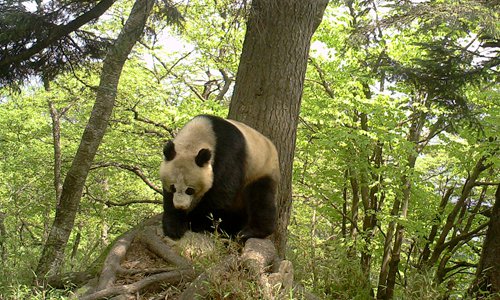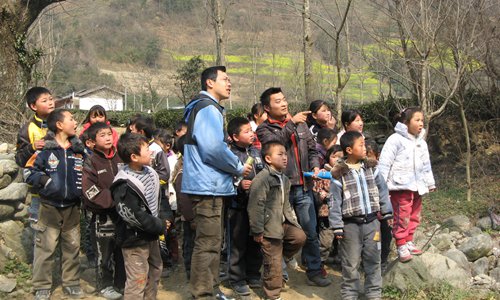
From the People's Daily App.
This is Story in the Story.
Wild giant pandas are not a rare sight in Liziba village in Northwest China's Gansu Province. In past decades, pandas were rarely spotted in the village, but that situation has changed in recent years.
The village is situated on the southern end of the Baishuijiang National Nature Reserve and was established to protect panda bears.
In 2017, China launched a trial run for the giant panda national park, and Baishuijiang was included. It is one of three panda reserves directly administered by China’s central government.
There are 132 wild giant pandas in Gansu Province and 110 live at the new reserve.
In 2018, the reserve installed about 700 infrared cameras for added protection.
Today, green plants cover the hills of Liziba, and villagers see the pandas as their neighbors rather than competitors for natural resources.
Today’s Story in the Story looks at China’s ongoing efforts at safeguarding the iconic panda bear and how one village is setting a global example by living amongst the beloved creatures.

(Photo: Photo: Courtesy of Baishuijiang National Nature Reserve)
On March 1, 2014, an adult panda wandered downhill through the bamboo woods and entered the village. Seeing humans around, the panda ran away after biting a villager's leg.
An investigation from 2009 to 2017 found that panda activity around the village had increased.
Liu Wannian, vice chief of the administration bureau of Baishuijiang reserve, believes the result has proven the effectiveness of panda protection work during previous years.
Rows of tea trees line the hills at the village, and more than 700 villagers make a living from this crop.
"This year it's $84 per one-half kilogram," said one villager.
"From 1990 to 2003, logging was severe here. You could hear the noise of woodcutting everywhere in the village. Black smoke rose in the mountains. The vehicles transporting wood were endless," said village secretary Ren Huazhang.
In 1999, the village was connected to the outside world through highways, which made things worse. Several acres of forests were cleared.
Forest patrols were established in 2003. The then village chief Ma Xiaolun led 20 active young farmers to form a volunteer patrol team.

Employees and volunteers at the reserve teach local children in Liziba village how to observe nature. (Photo: Courtesy of Baishuijiang National Nature Reserve)
While the patrol team managed to bring down illegal kilns and put out fires in the forests, they still lacked funds. Moreover, as the patrol team was not officially authorized, they did not have much power to enforce t he law.
When experts from Baishuijiang National Nature Reserve and the Beijing-based ShanShui Conservation Center conducted research into the village’s bio-diversity, they found it was facing internal and external threats.
People would raid the forests and conduct illegal hunting and logging.
At the same time, villagers needed large amounts of firewood in their daily lives, and pollution was also severe in certain places.
The community patrol team consisted of 26 villagers, who monitored six routes selected by the project every season and also patrolled four routes every month.
During the project’s first year, wildlife activity in the region increased.
As part of the project, villagers and local school students also received education on wildlife and ecological protection.
Liu Wannian once spotted four giant pandas in two days.
He saw a panda lazing in a tree and enjoying the sunshine near the village.
After Liu and his colleagues took some photos, the panda climbed down from the tree and disappeared into the bamboo forest.
The next day, Liu encountered an adult panda near a stream. "The panda saw the cameras and posed for a while, then left," Liu said.
Once, during mating season, they heard panda sounds and found two of them singing "love songs" to each other.
"In recent years, protection work has been steady, and the ecology here has gradually improved. Giant panda numbers have also increased," He Liwen, office chief at the reserve's administration bureau said.
For the last 10 years, Liziba has encouraged the community to join in reserve protection efforts.
China aims to set up national parks and form a unified management system by 2020.
The newly designed national panda park is 27,100 square kilometers in area and covers 12 cities and prefectures in Sichuan, Gansu and Shaanxi provinces, and will also involve 200,000 residents.
Human dwellings sit between the panda habitats, which means communities must play a significant role in protection work.
According to one expert, "Due to tourism, infrastructure construction, and climate change, isolated panda groups have a high risk of extinction."
(Produced by Nancy Yan Xu, Lance Crayon, Brian Lowe. Music by: bensound.com. Text from China Daily.)


